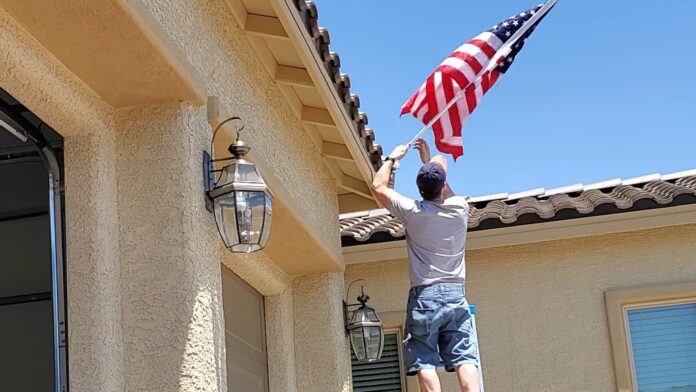Throughout my years as an electrician, I’ve tackled a myriad of projects, from complex wiring systems to simple household installations.
One project that’s often overlooked but can add a touch of brilliance to your home or business is lighting up a flagpole.
This might seem complicated at first glance, but with the right tools and guidance, it can be a straightforward task. Here’s a detailed guide to get you started.
What You Must Know About Flagpole Lighting
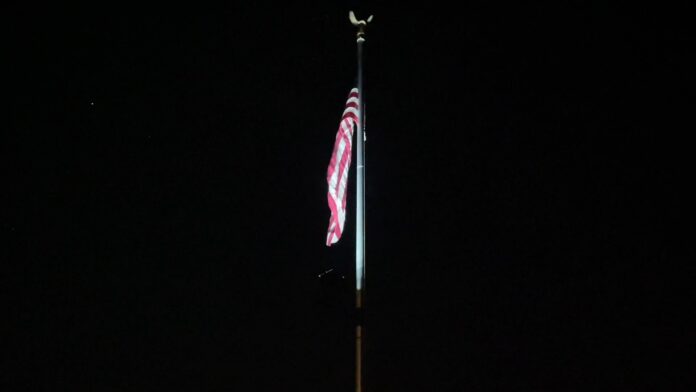
Flagpole lighting serves two main purposes: aesthetic enhancement and adhering to the U.S. Flag Code, which recommends that the American flag be illuminated if displayed at night. Proper lighting ensures your flag remains visible even after the sun sets.
Types
There are several options to consider when choosing flagpole lights:
- Spotlights: These are ground-based lights that direct a beam upwards, illuminating the flag. They’re easy to install and come in various brightness levels.
- Solar Lights: Solar flagpole lights are energy-efficient and eco-friendly. They come with solar panels that charge during the day and light up the flag at night.
Placement
The position of your lights matters:
- Ground Level: Place lights at the base of the flagpole, pointing upwards. This offers a dramatic effect, casting shadows as the flag flutters.
- On the Pole: Some lights can be attached directly to the flagpole. These evenly light up the flag without casting heavy shadows.
Installation Steps for Flagpole Lighting
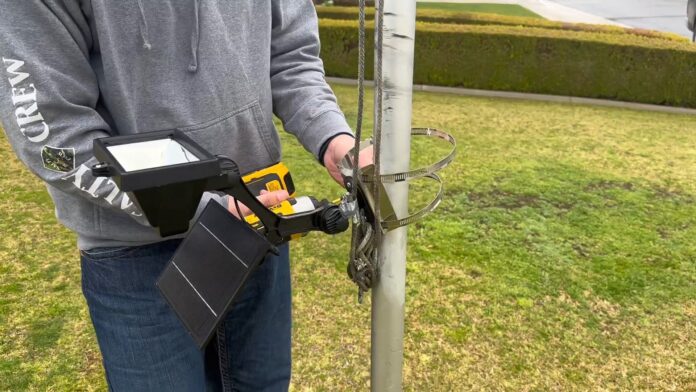
With a clear understanding of the basics, let’s delve into the actual installation process.
Preparing the Area
Before starting:
- Safety First: Turn off all power sources before beginning the installation. Always wear gloves and protective gear.
- Gather Tools: Have all your tools and lights ready. This includes spotlights, cables, a shovel (for ground installations), and a ladder.
Setting Up the Lights
After prepping the area:
- Spotlight Installation: Dig a small hole to place your spotlight. Aim it upwards towards the flag. Connect the light to a power source and ensure it’s waterproofed.
- Solar Light Installation: If using a solar light, position the solar panel in a location with maximum sunlight. Attach the light to the flagpole or position it on the ground, as preferred.
Maintenance and Safety Tips
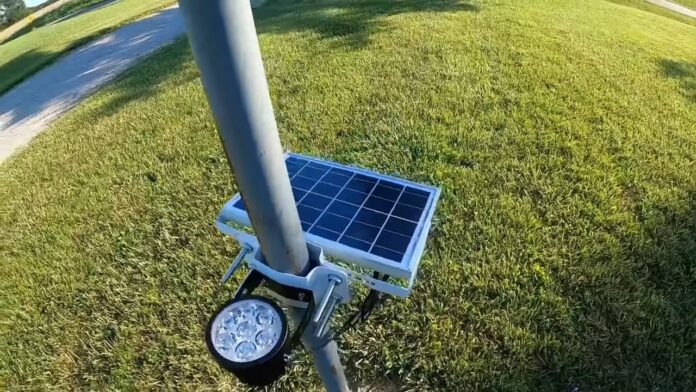
A well-lit flagpole can be a sight to behold, but maintaining that brilliance requires some care.
Regular Maintenance
To ensure longevity:
- Clean Regularly: Dust and dirt can accumulate on lights, reducing their brightness. Clean them regularly to ensure optimal illumination.
- Check Connections: Periodically check for any loose connections or exposed wires. Fix them promptly to prevent electrical mishaps.
Safety Precautions
Safety should always be a priority:
- Avoid Overloading: Never connect too many lights to a single power source. This can lead to overheating and potential fires.
- Weatherproofing: Ensure all connections are waterproofed, especially for outdoor installations. This will prevent short circuits during rainy or wet conditions.
Factors to Consider When Choosing Lights
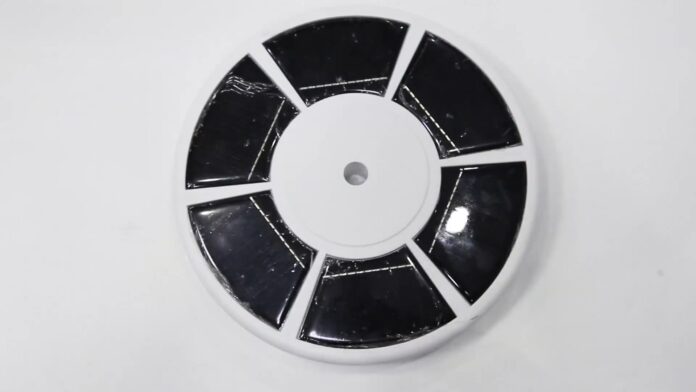
Before making a purchase, there are several factors you should evaluate to ensure you select the right lights for your flagpole.
Brightness and Coverage
Consider the following:
- Lumen Output: Higher lumen output means brighter lights. Consider how bright you want your flag to be illuminated and choose accordingly.
- Coverage Area: Ensure the light’s beam width is enough to cover the entire flag, especially if it’s a larger one.
Energy Efficiency and Cost
Cost-saving options:
- LED Lights: LEDs are energy-efficient and have a longer lifespan than traditional bulbs. They may have a higher upfront cost, but they save money in the long run.
- Solar Options: Solar lights reduce energy costs. Though they depend on sunlight for charging, most models store enough power to last through the night.
Troubleshooting Common Issues
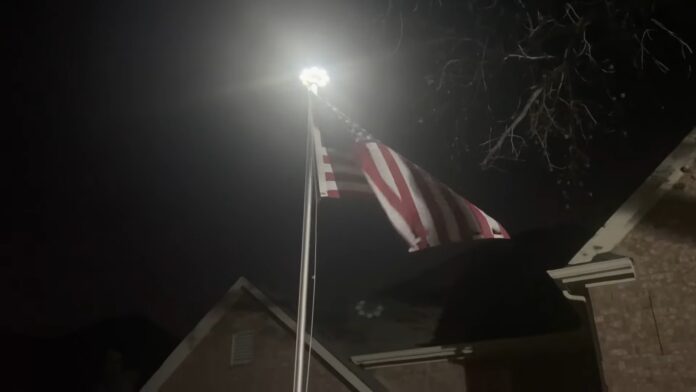
Even with the best installation, you might face some issues. Here’s how to tackle the common ones.
Dimming Lights or Inconsistent Brightness
Possible solutions:
- Replace Bulbs: Over time, light bulbs can dim. If you notice reduced brightness, it might be time for a replacement.
- Clean Solar Panels: If you’re using solar lights and they’re dimming, ensure the panels are clean. Dirt or debris can reduce their charging capacity.
Lights Not Turning On
Steps to remedy:
- Check Connections: Ensure all wires are correctly connected and there’s no damage.
- Test the Power Source: Sometimes, the issue might be with the power source or outlet. Check if other devices work on the same source.
Enhancements and Additional Features

Beyond basic illumination, there are features that can elevate the look of your flagpole.
Light Sensors and Timers
Enhance functionality with:
- Dusk to Dawn Sensors: These sensors automatically turn on the lights when it gets dark and turn them off at dawn.
- Timers: Set timers to switch on and off at specific times, ensuring your flag is lit only when needed.
Color Options and Modes
For special occasions:
- Color-changing Lights: Some lights come with the ability to change colors. This can be useful for special events or holidays.
- Flashing or Pulsing Modes: Some models offer different lighting modes, like flashing or pulsing, adding a dynamic touch to your flagpole.
Adapting to Different Flagpole Heights

The height of your flagpole can dictate the type and positioning of lights. Here’s how to adjust your approach based on flagpole size.
Short Flagpoles (Under 20 feet)
Key points to remember:
- Single Spotlight: Often, a single bright spotlight positioned at the base can sufficiently illuminate shorter poles.
- Avoid Over-illumination: Too bright a light can wash out the flag. Choose a light with a moderate lumen output.
Tall Flagpoles (Over 20 feet)
For larger poles:
- Multiple Lights: Consider using multiple spotlights positioned around the base to ensure even illumination.
- Higher Lumen Output: Choose lights with a higher brightness level to adequately light up flags on taller poles.
Evaluating and Adjusting Light Angles
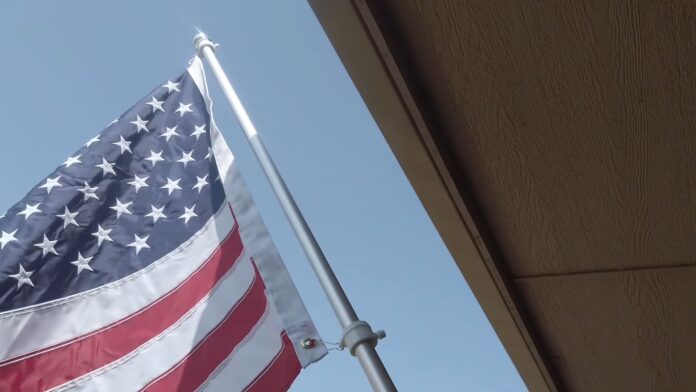
The angle at which your lights hit the flag can greatly influence its visibility and aesthetics.
Direct vs. Diffused Lighting
Understand the difference:
- Direct Lighting: This is when the light beam hits the flag straight on. It provides clear illumination but may cast sharp shadows.
- Diffused Lighting: Positioning lights at an angle can offer a softer, more diffused glow. This minimizes shadows and offers a gentle illumination.
Experimentation is Key
To find the best angle:
- Adjust Regularly: After installation, take a few nights to adjust and see which angle best showcases your flag.
- Seek Feedback: Ask neighbors or friends about the visibility from different points of view.
Weather and Seasonal Considerations
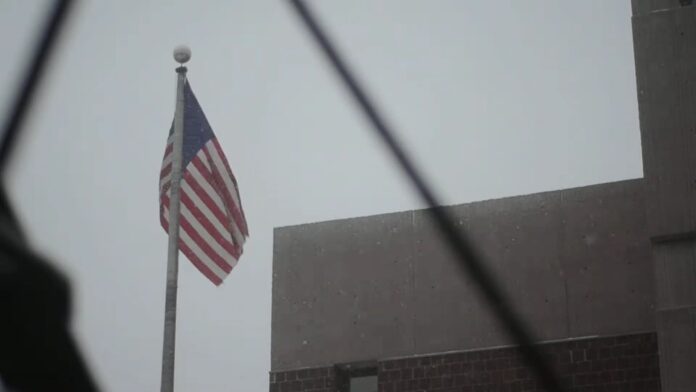
Weather conditions and seasons can affect your lighting setup. Here’s how to adapt:
Winter and Snowy Conditions
For colder months:
- Clear Snow: Ensure lights and solar panels are free from snow accumulation to maintain brightness.
- Weatherproofing: Ensure all connections and lights are sealed well to prevent moisture ingress.
Rainy and Wet Conditions
For wetter climates:
- Elevate Lights: Consider elevating ground-based lights slightly to prevent water pooling.
- Check Drainage: Ensure the area around your flagpole has good drainage to avoid water-related issues.
FAQs
Can I use indoor lights for my flagpole?
No, indoor lights are not designed to withstand outdoor conditions. For flagpole lighting, it’s essential to use outdoor-rated lights that can handle weather changes and other external factors.
How often should I replace the bulbs in my flagpole lighting system?
The frequency of replacement depends on the type of bulb and its usage. LED lights, for instance, can last up to 25,000 hours or more.
It’s a good practice to check the brightness regularly and replace bulbs when they start dimming or malfunctioning.
Do I need a professional to install my flagpole lights?
While many lighting setups can be done DIY, if you’re not comfortable with electrical installations or if your desired setup is complex, it’s wise to consult or hire a professional to ensure safety and proper functionality.
Can I use colored lights to illuminate my flag?
While there’s no strict rule against using colored lights, it’s essential to ensure that the flag’s colors are still distinguishable.
Overly saturated or contrasting colors might distort the flag’s appearance, which might not be respectful or in line with flag codes.
What’s the best way to power my flagpole lights if I don’t have an electrical source nearby?
Solar-powered flagpole lights are an excellent option for locations without a nearby power source.
They charge during the day and can provide illumination throughout the night without the need for electrical wiring.
Do flagpole lights attract insects?
Like most lights, flagpole lights can attract insects, especially during warmer months.
However, some LED lights emit a spectrum of light less attractive to bugs, which can be an option if this is a concern for you.
Final Words
By now, you should be well-equipped with the knowledge to light up your flagpole effectively and efficiently.
With the right lights and techniques, your flag will not only honor its symbolic significance but also enhance the aesthetics of your surroundings.
And remember, regular maintenance and safety are key to enjoying the brilliance of your illuminated flagpole for years to come.

